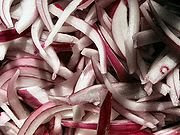 Fried rice is something we've all enjoyed at Chinese restaurants, but not everyone has had success at preparing it at home. We've found that the key to getting a good batch of fried rice out of the wok is cooking and pre-chilling the rice well ahead of time.
Fried rice is something we've all enjoyed at Chinese restaurants, but not everyone has had success at preparing it at home. We've found that the key to getting a good batch of fried rice out of the wok is cooking and pre-chilling the rice well ahead of time.Regarding the various ingredients you add to the rice, it's entirely up to your taste buds and what you have on hand. As with many of the recipes we post here, fried rice is something that can absorb a number of things you may have sitting around the kitchen.
This recipe is enough to serve about six. We had it recently along with Indonesian Salad Rolls with Coconut Peanut Sauce (click here for recipe), and some salad greens dressed with a light lime-ginger-soy-sesame dressing.
1.5 cups long grain white rice
3 cups water
1/2 tsp. salt
1 cup frozen peas, cooked and drained
2 Tbsp. peanut oil

1 red onion, peeled and diced
12 green onions, cleaned, trimmed and thinly sliced
2 Tbsp. minced fresh ginger
4 cloves garlic, peeled and minced
2 stalks celery, trimmed and diced
1 cup broccoli florets, cut into bite-size pieces
1/2 red bell pepper, cored and diced
3 eggs, scrambled
1 Tbsp. peanut oil
1/2 lb. medium shrimp, peeled and deveined
3 Tbsp. low sodium soy sauce
 Pour the rice into a fine-mesh strainer and rinse with water. Repeat this several times until the water that drains off is relatively clear. Bring the water and salt to a boil in a medium saucepan, add the rice and lower the heat. Cover the pan and allow to simmer on low heat for about 15 minutes undisturbed. When it's cooked through and all water has been absorbed, remove from heat and allow to cool. After it's cooled down to near room temperature, transfer the pan to a refrigerator and chill for several hours.
Pour the rice into a fine-mesh strainer and rinse with water. Repeat this several times until the water that drains off is relatively clear. Bring the water and salt to a boil in a medium saucepan, add the rice and lower the heat. Cover the pan and allow to simmer on low heat for about 15 minutes undisturbed. When it's cooked through and all water has been absorbed, remove from heat and allow to cool. After it's cooled down to near room temperature, transfer the pan to a refrigerator and chill for several hours.Heat the peanut oil in a large wok and add the diced onion. Stir-fry for about a minute, then add the green onions, garlic and ginger. Stir-fry for a couple of minute until fragrant.
Add the celery, broccoli and bell peppers and stir-fry for a few minutes, until softened slightly.
Shove the veggies to one side of the wok and move the empty side directly over the heat. Pour in the scrambled eggs and cook until set, stirring often. Chop up the eggs, then stir them into the veggies. (If you're uncomfortable doing the eggs this way, you can always cook them in a separate non-stick skillet, cut into small pieces, then add to the rice.)
Meanwhile, take the chilled cooked rice and break it up by hand into a large bowl, so that you have generally individualized grains. Pour the rice into the wok and stir-fry until cooked through.
Heat the remaining oil in a separate saute pan and add the shrimp. Saute just until cooked through and opaque. Stir the cooked shrimp into the fried rice. If you have anyone in your group who can't eat shellfish or doesn't like shrimp, you can serve the shrimp on the side and everyone can add shrimp to their fried rice at serving time.

Sprinkle the fried rice with the soy sauce, stir and serve immediately.
A final note: Fried rice is a lot of work. If you want your fried rice "easy" then Google the nearest Chinese restaurant and go for the "take-out" option.















































